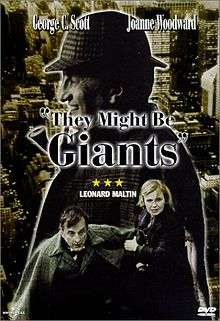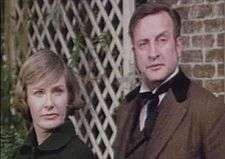They Might Be Giants (film)
| They Might Be Giants | |
|---|---|
 DVD cover | |
| Directed by | Anthony Harvey |
| Produced by | John Foreman |
| Written by | James Goldman |
| Starring |
George C. Scott Joanne Woodward Jack Gilford Rue McClanahan |
| Music by | John Barry |
| Cinematography | Victor J. Kemper |
| Edited by | Gerald B. Greenberg |
| Distributed by | Universal Pictures |
Release dates |
|
Running time | 98 minutes |
| Country | United States |
| Language | English |
They Might Be Giants is a 1971 film based on the play of the same name (both written by James Goldman) starring George C. Scott and Joanne Woodward. Sometimes mistakenly described as a Broadway play, it never in fact opened in the USA. It was directed in London by Joan Littlewood in 1961, but Goldman believed he "never got the play right" and forbade further productions or publication of the script. To coincide with the film's release, however, he did authorize an illustrated paperback tie-in edition of the screenplay, published by Lancer Books.
The movie later lent its name to a popular music group.
Plot summary

Justin Playfair (Scott) is a millionaire who retreats into fantasy after his wife's death, imagining himself to be Sherlock Holmes, the legendary fictional detective. Complete with deerstalker hat, pipe and violin, he spends his days in a homemade criminal laboratory, constantly paranoid about plots hatched by his (Holmes's) archenemy, Professor Moriarty.
When his brother (Lester Rawlins) tries to place Justin under observation in a mental institution so he can get power of attorney, Justin attracts the attention of Dr. Mildred Watson (Woodward), a psychiatrist who becomes fascinated by his case. Justin demonstrates a knack for what Holmes describes as "deduction" (technically better categorized as abductive reasoning) and walks out of the institution during the ensuing confusion. Watson comes to his home to attempt treatment. Playfair is initially dismissive of Watson's attempts to psychoanalyze him, but when he hears her name, he enthusiastically incorporates her into his life as Doctor Watson to his Holmes.
The duo then begin an enigmatic quest for Moriarty, with Playfair/Holmes following all manner of bizarre and (to Watson) unintelligible clues, and the two growing closer to each other in the process.
Defining quote
The title is an indirect reference to Don Quixote's famous exploit of tilting at windmills, believing them to be "monstrous giants". Despite the protest of his aide Sancho Panza and being soundly defeated at the hands of the "giants" (that is, being tossed away by a mill's sail after getting his lance caught in it), Quixote maintains his belief that the mills are not buildings but giants. In reference to this, Playfair argues:
Of course, he carried it a bit too far. He thought that every windmill was a giant. That's insane. But, thinking that they might be... Well, all the best minds used to think the world was flat. But, what if it isn't? It might be round. And bread mold might be medicine. If we never looked at things and thought of what they might be, why, we'd all still be out there in the tall grass with the apes.
Critical views
The film opened to mixed reviews. Vincent Canby of The New York Times described it as "a mushy movie with occasional, isolated moments of legitimate comedy."[1] Leonard Maltin was a notable critic to hold it in good esteem.[2]
It has a 78% positive rating from 9 reviews on the movie-review aggregate site Rotten Tomatoes.[3]
Releases
Intact copies of the film are difficult to find. Most home video releases have been edited. The original release length was 88 minutes. Netflix's streaming version is 91:15. A version edited for television in 1986 was 96:29. The currently available on-demand DVD runs slightly over 87 minutes; the longer versions include an extended scene in the grocery store.
References
- ↑ The New York Times: "They Might Be Giants"
- ↑ 3 stars on the DVD cover
- ↑ Rotten Tomatoes.com: "They Might be Giants"
External links
| Wikiquote has quotations related to: They Might Be Giants (film) |
| Wikimedia Commons has media related to They Might Be Giants (film). |